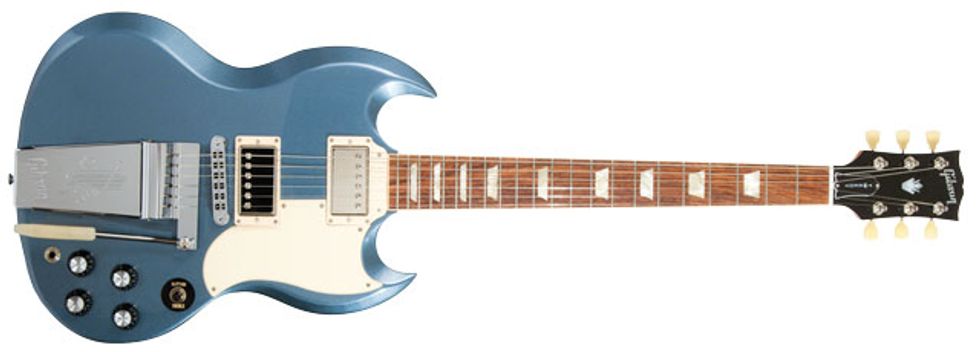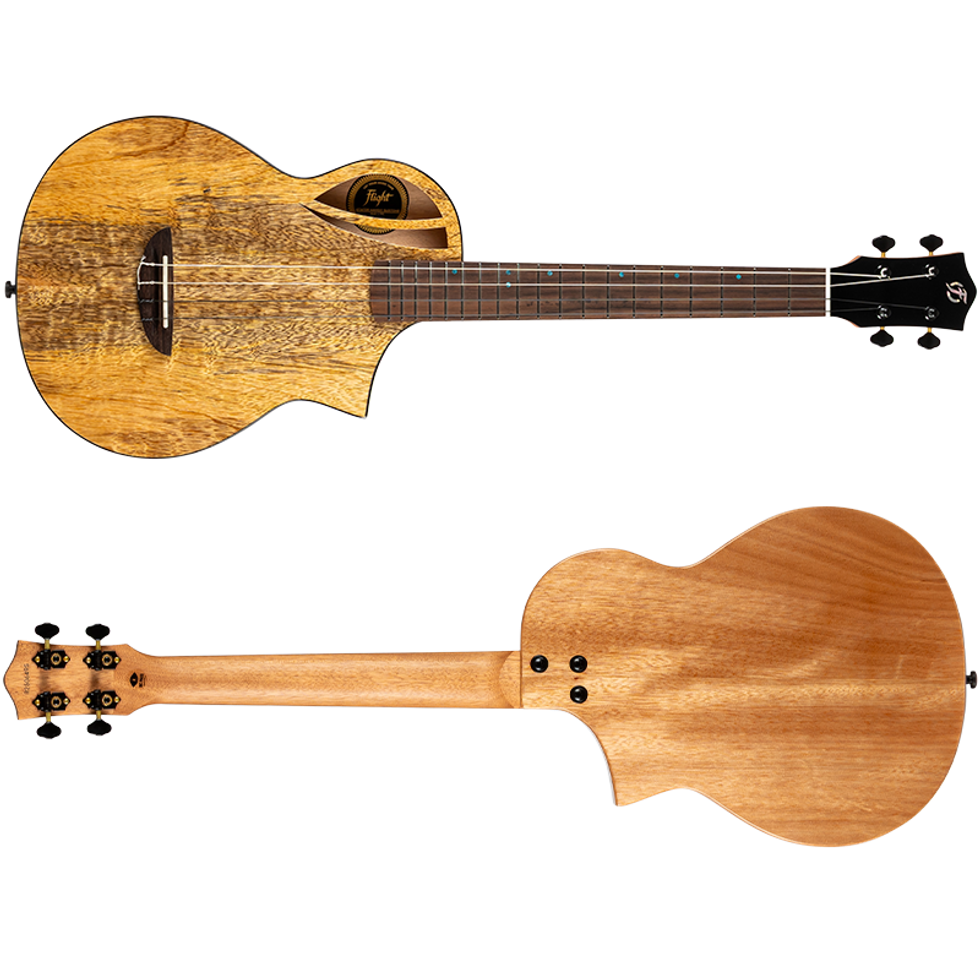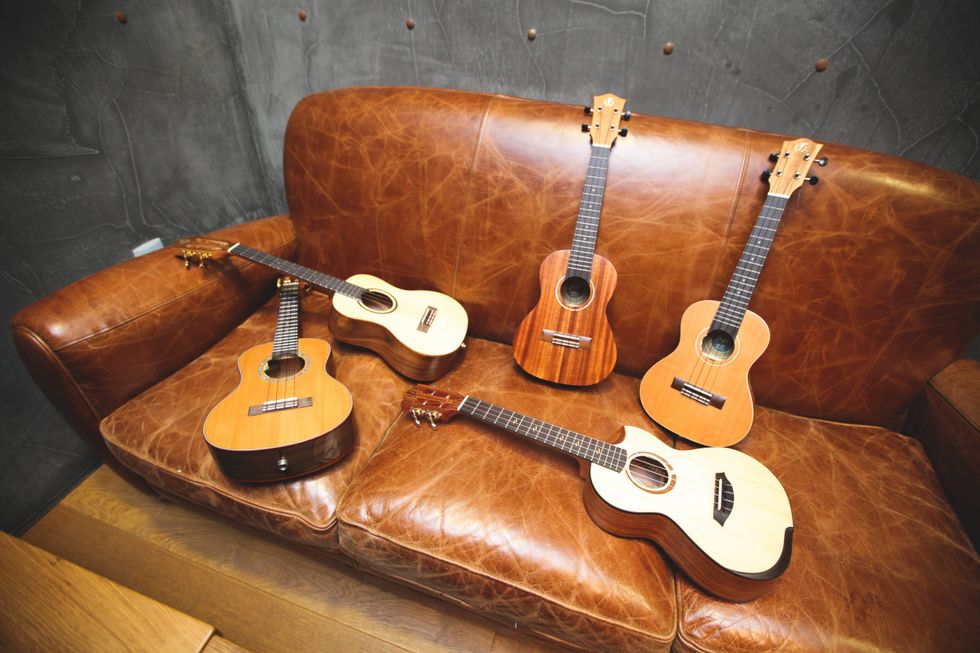The Gibson SG has served all kinds of guitarists since replacing the Les Paul as Gibson’s front-line solidbody in 1961. But for most players, the devil-horned, mahogany SG screams rock above all else.
And let’s face it—if you want a fast fretboard, simplicity, and the power to drive a 100-watt Marshall to house-wrecking levels, a PAF-equipped SG with a Tune-o-matic is hard to top. But over the SG’s life span, the model appeared in less famous iterations that were about much more than brute force and bossy humbucker tones. One of the most beautiful of these—the SG Standard with Maestro Vibrola—appeared in the early-to-mid ’60s, presumably to give the SG a little more appeal to players tempted by Fender’s hip and very musical vibrato systems. But the SG/Maestro combo resulted in what a lot of Gibson spotters consider the most elegant version of the instrument, and a unique Gibson in terms of tone, versatility, and musicality.
Wilco founder Jeff Tweedy found a lot of inspiration in those aspects of the Maestroequipped SG over the last decade. And Tweedy’s extensive use of the model—which ranges from free-and-ripping solo work to rock-solid rhythm—prompted Gibson to unveil a Jeff Tweedy signature model in his honor. Delightfully, the Tweedy turns out to be an SG of many shades—a versatile guitar brimming with sonic flavors that often defy expectation and clichés about what the SG can do.
Better in Blue
Though the Firebird was Gibson’s favorite
canvas for their own Fender-fighting custom
colors in the ’60s, SGs ended up on the
receiving end of the sprayer too, and though
custom color SGs are relatively rare, the compact
and bold lines of the guitar looked great
in Gibson’s custom hues. Tweedy rocked a
pelham blue model onstage a lot over the last
several years, and that guitar was the aesthetic
departure point for the Tweedy SG.
The Tweedy SG is flat-out gorgeous. The blue, crème, and chrome color scheme is a welcome deviation from the iconic, but ubiquitous cherry finish, and lends a nice touch of femininity to an axe that otherwise tends to exude machismo. Visually, the guitar could not be better balanced, and the combination of color and design makes the Tweedy a guitar that stops folks who don’t know a SG from a banjo dead in their tracks.
The blue mist nitrocellulose finish is applied in a manner that reveals a lot of the grain in the mahogany, and the metallic flake is a little more sedate than you see on the similar pelham blue finish. It’s a cool look that, again, softens some of the flash of the chrome and custom color. Both the Kluson Deluxe tuning buttons and the Vibrola vibrato grip are crafted from pearloid, lending yet another classic and almost delicate touch that compliments the color scheme beautifully.
Unlike SG Standards, which have matching body and neck finishes, the Tweedy’s mahogany neck has a natural, not-quite-satin, not-quite-glossy finish that’s a nearly perfect compromise between the two. The silky feel compliments the early-’60s profile neck, and the 1.695" nut width creates a string spacing that’s both spacious and fast. The natural finish also gives the Tweedy a little extra dose of Scandinavian design flavor that tempers the flashier aspects of the guitar.
Many Shades of SG
It’s not hard to make the Tweedy SG bark
like an SG should. Sporting alnico 2 magnets,
the guitar’s BurstBucker 1 pickups
are about the closest thing Gibson has to
’59-vintage PAFs in sound and specification,
and when you crank them up in
front of a wide-open blackface Deluxe, the
Tweedy growls and sings depending on
your pick attack and pickup combination.
The bridge pickup is both bright and full, though not quite as rotund as a Les Paul. In fact, chords played with the volume and tone wide open can have a sort of brashness and a not-unpleasant rasp that you can probably chalk up to the Maestro tailpiece, which transfers vibration less directly to the mahogany body and adds a bright-ish resonance.
The neck BurstBucker is also tinged with a touch of brightness—again probably helped in no small part by the Vibrola and mahogany body—that makes the Tweedy a lot less muddy and somber in the neck position. If you’ve ever walked away from a Les Paul or SG because the neck pickup sounded like sludge, the Tweedy might have you thinking twice. The neck pickup makes a great, if unexpected, match for jangly arpeggios and funky percussive vamps.
In general, the interplay between the BurstBuckers, the Tweedy’s mahogany construction, and the lively and metallic Vibrola translates to a little less attack and sustain. But this also means the Tweedy is both harmonically rich and a little more succinct, qualities that yield a lot of voices and character.
The volume pots have great range and are essential to making the most of the BurstBuckers’ sonic palette—especially on the bridge pickup—if you’re playing anything other than pedal-to-the-metal rock. Backing off the volume knob a touch is great for tight, concise, and defined Revolver-era Harrison tones—particularly if you run the guitar through an amp with tight, natural compression, like an AC30, or a smaller Fender amp with a little pedal compression and an aggressive treble setting. But you can also extract a nice range of Telecaster- and quasi-Strat-like tones, depending on your pick attack and where you set the volume knob.
Backing off the tone just a touch and moving within the higher third of the volume range conjures the magical biting clarity of Jerry Garcia’s ’69-era tones, or Dickey Betts honey-sweet sting with just a hint of single-coil grit. Switching to the neck pickup grants access to the softer realms of Garcia and Betts’ SG tones—like the beautifully spacious and spacey textures from the opening minutes of “Dark Star” or “In Memory of Elizabeth Reed.” In this context, the softened attack that you get from the Vibrola is less pronounced, but the unique, ringing harmonic characteristics of the system give the familiar, fat PAF tone a more bell-like quality. Similar settings work for jazz maneuvers, and rolling back the tone knob gives you a smooth voice for octave and more complex chords. You won’t mistake this sound for an L-5, but it’s a nice compromise between traditional Gibson rotundity and a solidbody’s high-end detail.
Ratings
Pros:
will contend for the prettiest guitar on the block.
interesting tone palate that deviates from sG convention.
Cons:
Vibrola is tough to keep in tune.
BurstBuckers can be brash when wide open.
Tones:
Playability:
Build:
Value:
Street:
$1,699
Gibson
gibson.com
The Vibrola is good for a lot more than adding a harmonic twist to the SG’s time-tested sonic signature, though it’s by no means a system without drawbacks. It’s challenging to keep in tune, it makes resting your hand behind the bridge difficult, and it took a few adjustments of the vibrato arm’s mounting screw to keep the arm from squeaking when moved back and forth. Though the Vibrola is impractical for deep whammy moves, or even Venturesstyle chord bends you can pull with ease on a Jazzmaster, it’s beautifully effective for feathering chords and the John Cippolina/ Fillmore ’68-style quick vibrato that Tweedy peppered his leads with over the last several years. This unit has a lively, bouncy feel that works particularly well if you use a hybridpicking or fingerstyle technique.
The Verdict
Dashing, well-dressed, and a welcome departure
from SG convention, the Jeff Tweedy
SG is the kind of knock-yer-socks-off gorgeous
instrument that inspires you to pick it
up and play. But it’s doubly inspiring once
you plug it in. Like any good SG, it’s a blast
to play, with a desert runway worth of fast
fretboard that invites slashing chord rhythms
and fleet-fingered leads in equal measure.
It also does just about everything you want an SG to do, from driving a fuzz into a glorious scuzzy frenzy to lending muscle to Chicago blues moves. It’s the interesting altered and—depending on your perspective— enhanced tone palate provided by the interaction of mahogany body and Vibrola, as well as the musical and quirky aspects of the Vibrola’s performance that make this guitar substantially different. And if you can get past the notion that you may have to use your tuner with a bit more frequency if you put the Vibrola to work, the beautiful—and beautifully playable— Jeff Tweedy SG will reward you with a unique and wide spectrum of sonic color.















![Rig Rundown: Russian Circles’ Mike Sullivan [2025]](https://www.premierguitar.com/media-library/youtube.jpg?id=62303631&width=1245&height=700&quality=70&coordinates=0%2C0%2C0%2C0)





